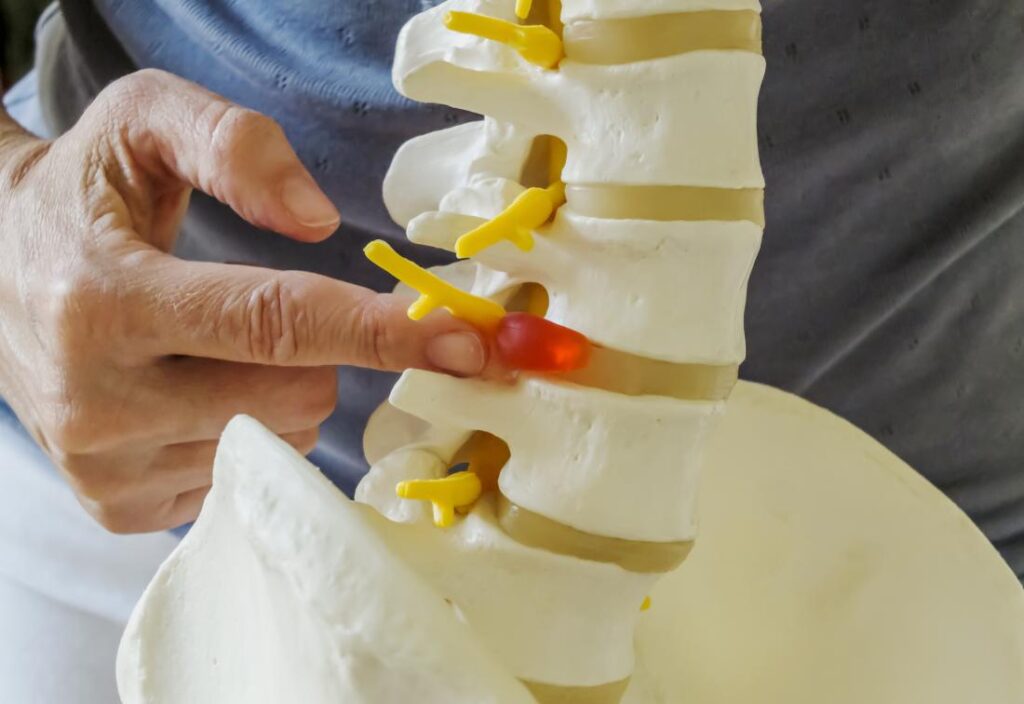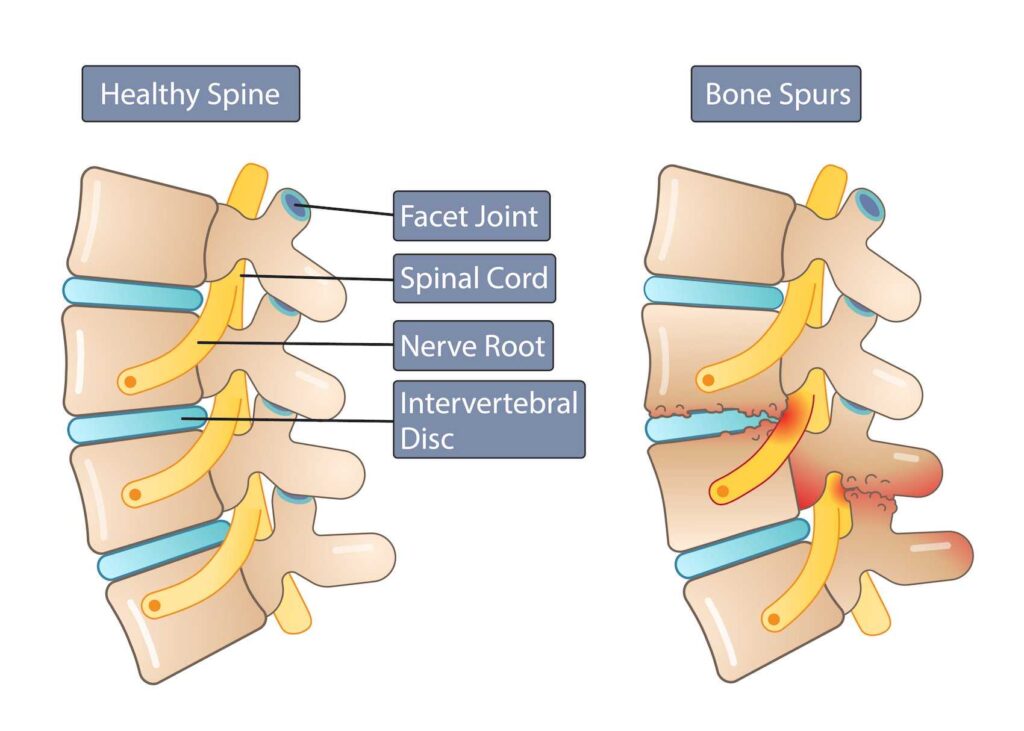BONE SPUR: OSTEOPHYTES
Are you are experiencing pain or weakness in your back? You may wonder it might be due to overexertion or from osteoarthritis. Sometimes osteoarthritis may also lead to the development of bone spurs in shoulder, neck, and back joints. Bone spurs develop as hard growths on the edges of bones and around joints. Some bone spurs may not cause pain but some of them may lead to back and neck pain.

Bone spurs are smooth, bony developments, mostly close to joints. Over the period they develop arthritis, joint pain, or joint damage. The feet, hands, knees, and spine regularly foster bone spurs. Following a healthy lifestyle can postpone signs like pain, solidness, and restricted movement.
When these bone spurs develop in your spine they are referred to as osteophytes, degenerative joint disease, degenerative disc disease, osteoarthritis, or spinal decay. Bone spurs or osteophytes develop at the point of bones meeting each other, i.e. in your joints. They can also develop on the bones of your spine. Surgery along with medication and physical therapy helps in recovery.

WHY DO BONE SPURS DEVELOP?
Bone spurs are most common in people 60 years or older, but younger people can get them, too. Osteophytes indicate the age of the problem, not the age of the person. Assuming that the spinal joint moves twisted and becomes stuck, the clock begins ticking. It might require quite a while before the main pointer, a roughened edge on the vertebra, starts to appear.
The spine consists of 33 bones to protect the spinal cord. The discs are filled with gel between the bones serve as shock absorbers. The discs also allow us to bend forward and backward and twist our backs in a variety of directions.
There are opening behind each disc and under each joint that allows a part of nerve roots to pass the spinal cord known as the foramen. The spinal cord will go to other parts of the body. Bone spurs can be a problem if they develop in the openings for the nerve roots. They make the space narrower and press on the nerve referred to as foramen stenosis.
Bone spurs lead to back pain in one of three ways:
- Joint inflammation: Bone spurs of the joints of the spine can make adjoining vertebrae grind against one another resulting in inflammation due to friction. The inflammation can prompt pain, stiffness, and different symptoms.
- Compression of a nerve root: The development of bone spurs can cause narrowing of the neural foramina, where the nerve roots exit the spinal column. With less space, the nerve roots may become compressed. Nerve root compression can cause paresthesia (tingling) if they become compressed. If the nerve root becomes inflamed, pain may occur.
- Compression of the spinal cord: Bone spurs can grow into the spinal canal, where the spinal cord travels, leaving less space for the spinal cord. Compression of the spinal cord can cause weakness, strength loss, pain, and other symptoms.
WHAT ARE THE SYMPTOMS OF BONE SPURS?
Bone spurs may not cause any signs or symptoms. The X-ray may reveal the development of bone spurs. Sometimes, the bone spurs can cause pain and loss of motion in your joints. Some of the symptoms of bone spurs depend on their location, such as:

- Knee: Bone spurs in your knee can make it painful to expand and twist your leg.
- Spine: The bone spurs on your vertebrae can narrow the space that contains your spinal cord. These bone spurs can pinch the spinal cord or its nerve roots causing cause weakness or numbness in your arms or legs.
- Hip: Bone spurs can make it painful to move your hip, even though you could feel the pain in your knee. The bone spurs can decrease the scope of movement in your hip joint.
Some of the other symptoms include:
- Pressure on nearby nerves.
- Restrict movement.
- Rub against other bones or tissues.
- Crooked or bumpy areas, especially in the fingers or toes.
- Numbness and weakness, especially in the legs if the spine has spurs.
- Pain near the affected joint, like heel pain.
- Reduced range of motion.
- Stiffness.
- Tendinitis.
- Tendon tears.
HOW DO DOCTORS IDENTIFY BONE SPURS?
Without indications, you may accidentally discover a bone spur during an X-ray or other test for a different condition.
In case of pain, stiffness, and loss of motion your healthcare provider will ask about:
- Your symptoms.
- Your medical history and family’s medical history.
- Rate your discomfort.
They would perform a physical examination and test your joint’s range of motion and strength. They may also recommend imaging tests, such as X-rays to look for arthritis and spurs or CT scans or MRIs to identify damaged ligaments or tendons.
HOW DO CHIROPRACTORS TREAT BONE SPURS?
The basic explanation for bone spurs structure in the spine is an absence of development. Each joint section ought to have the option to move and capacity as planned. Chiropractic care finds the spinal portions that are not working the way they ought to. Your bone and a joint specialist will track down these vertebrae, change them, and reestablish their typical development.
The rebuilding of development won’t switch spinal degeneration, yet it can prevent the cycle from proceeding and assist you with reestablishing the typical scope of movement and keeping away from a medical procedure.
The indications from bone spurs can be improved with rest, so you might have to have some time off from sports or working out until you recuperate. If you have actual work, you might need to take NSAIDs to loosen up muscles and soothe any pain. Certain individuals likewise have steroid chances into the joint case, which can decrease enlarging and free the manifestations from bone spurs.
Your bone and joint specialist can likewise assist you with mitigating pain from bone spurs with spinal controls. Spinal controls can be very useful assuming you have restricted portability or experience nerve pressure. With spinal control, your alignment specialist can assist with realigning vertebrae to address your stance.

Changes can likewise alleviate tension on squeezed nerves. Your chiropractor might perform cervical footing. During this treatment, the head and neck are softly pulled to isolate vertebrae and decrease tension on the spine.
Other than changes, your alignment specialist may likewise offer active recuperation and back rub treatment administrations. Exercise-based recuperation can help you fortify and extend your neck and back muscles and separate bonds that might have shaped stressed muscles.
Assuming bone spurs can lead to muscle fits, rub treatment can be gainful since it can loosen up monitored muscles, support dissemination, and lessen fiery reactions.

OUTLOOK
Bone spurs may cause no symptoms at all or may drastically affect your day-to-day life. Home remedies and lifestyle choices can help you delay or ease symptoms. If you can’t control your pain or other symptoms on your own, ask your healthcare provider about additional strategies.
People Also Read:
What Is Low Back Pain?
Minimize Back Pain Using Chiropractic Adjustments
If you or anyone you know is suffering low back pain, our expert providers at Zenith Injury Relief & Wellness Clinic will take care of your health and help you recover.
Call us on 972-210-0033 to book an appointment with our specialists, and begin living your life pain-free.
